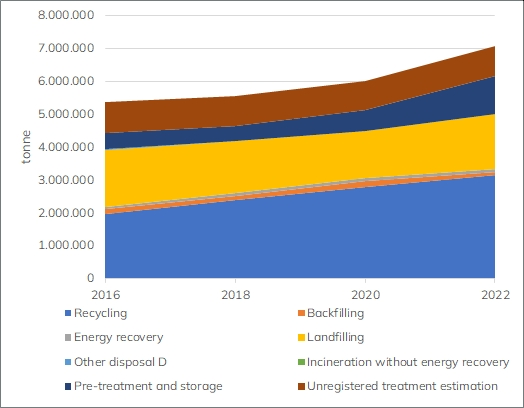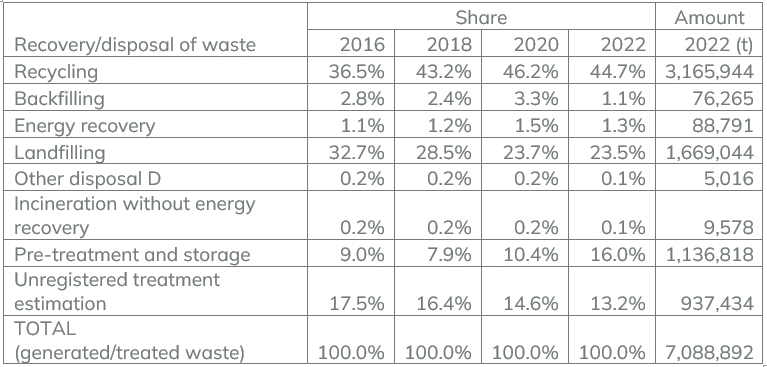About the indicator "Waste treatment"
By monitoring the total amount of waste treatment, it is possible to evaluate progress in the application of the circular economy concept, i.e. more efficient use of resources. The indicator monitors the recovery or disposal of waste as well as progress in achieving the goal of sustainable waste management and improving the management system of certain types of waste.
Objective
• progress towards a circular economy, efficient use of resources, sustainable waste management, i.e. the application of hierarchy in waste management
Description


In the EU-27, waste treatment amounted to 1,992 million tons in 2022. The amount of waste recovery increased by 36.3% from 2004 to 2022. The share of recovery in total waste treatment increased from 45.9% in 2004 to 61.4% in 2022 (recycling accounted for 40.8%, landfilling 14.2%, and energy recovery 6.4%). The share of disposal in total waste treatment decreased from 54.1% in 2004 to 38.6% in 2022 (landfilling accounted for 30.2%, incineration without energy recovery 0.4%, and other disposal 8, 0 %).
In the Republic of Croatia, as a result of the increase in the amount of generated waste, the waste treatment is also increasing, but with a positive shift in waste management hierarchy. The recycling rate of the total generated waste increased from 36.5% in 2016 to 44.7% in 2022, and the disposal rate of the total generated waste decreased from 32.7% to 23.5% in 2022.
In 2022, 44.7% of the total generated waste was recycled, 1.1% was recovered through the backfilling operation, and 1.3% was subject to energy recovery. Thus, the recovery rate in 2022 for the total waste generated in the Republic of Croatia is 47.1%.
Share of 23.5% of the generated waste was disposed of, while a negligible amount of waste, 0.1%, was incinerated without energy recovery. Estimates for unrecorded handling of waste amount to 13.2% (construction waste, waste from extractive industry and municipal waste).
Not all generated amounts of waste are treated In Republic of Croatia. In 2022, 5,067,660 tons of waste which was generated in the territory of the Republic of Croatia, i.e. 71.5% of the total amount, was processed by final treatment operations (D1-D7, D10, D12, R1-R11). These are the final treatment procedures (mainly recycling and disposal) which are not followed by further treatment of the waste. The remaining amounts of generated waste (2,021,232 tons) were treated i.e. by preparatory operations (sorting, dismantling, shredding, mixing, etc.) prior to shippment for final treatment, or were shipped out of Republic of Croatia directly, without pre-treatment.
Certain amount of waste refers to unregistered management of waste that is estimated, in case of construction waste, waste from extractive industry and municipal waste.
In 2022, waste shipment outside Republic of Croatia amounted to 1,021,607 tons. On average, 95% of the amount of waste shipped out of the Republic of Croatia is materially recycled, about 3% is energy recovered, while the rest of 2% is mostly incinerated without energy recovery and, to a lesser extent, disposed of in landfills.
Legal framework
- Regulations of the Republic of Croatia: Waste Management Plan of the Republic of Croatia for the period 2023 to 2028 (OG 84/2023); Waste Management Act (OG 84/2021, 143/2023); Ordinance on the Environmental Pollution Register (OG 3/2022); Ordinance on waste management (OG 106/2022).
- EU and international regulations: Directive 2008/98/EC on waste (Waste Framework Directive); Regulation (EC) 2150/2002 on waste statistics
Methodology
- Waste statistics (for hazardous and non-hazardous waste) are compiled in accordance with EUROSTAT's methodology prescribed by Regulation (EC) no. 2150/2002 on waste statistics. Waste statistics are compiled according to the statistical categories of waste defined by the same Regulation, and according to the recovery R/ disposal D waste operation list.
- Waste statistics are compiled on the basis of data collected in the Waste Management Information System, mostly reported in the Environmental Pollution Register (ROO) by waste code (in accordance with the Waste Catalog from the Ordinance on Waste Management, which is harmonized with European List of Waste) and by recovery R /disposal D operations (Appendix I and II of the Law on waste management).
Sources
- Ministry of Environmental Protection and Green Transition (MZOZT)
Data collection
- Production of statistics - biannual
Documents
Ministry of Environmental Protection and Green Transition
o Waste statistics - data sets
• EUROSTAT:
Updated: 5 Feb 2025